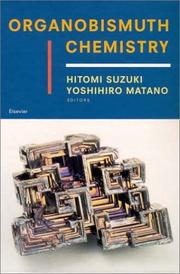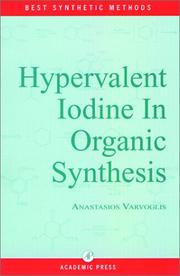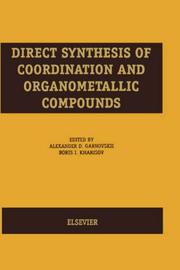| Listing 1 - 10 of 426 | << page >> |
Sort by
|
Multi
ISBN: 9780128038871 012803887X 9780128038147 0128038144 Year: 2017 Publisher: London, [England] : Academic Press,
Abstract | Keywords | Export | Availability | Bookmark
 Loading...
Loading...Choose an application
- Reference Manager
- EndNote
- RefWorks (Direct export to RefWorks)
Multi
ISBN: 9780128093702 0128093706 9780128093771 Year: 2017 Publisher: Amsterdam, Netherlands : Elsevier,
Abstract | Keywords | Export | Availability | Bookmark
 Loading...
Loading...Choose an application
- Reference Manager
- EndNote
- RefWorks (Direct export to RefWorks)
Multi
ISBN: 9780128122853 0128122854 0128122846 9780128122846 Year: 2018 Publisher: London Academic Press
Abstract | Keywords | Export | Availability | Bookmark
 Loading...
Loading...Choose an application
- Reference Manager
- EndNote
- RefWorks (Direct export to RefWorks)
Catalytic Amination for N-Alkyl Amine Synthesis provides a useful survey of this key type of reaction for chemistry researchers in academia and industry. Beginning with an introduction to amination and the development of the field, the book focuses on useful and high potential methods, such as the catalytic amination of alcohol with homogeneous and heterogeneous catalysts, the coupling reaction of olefin and amine, and the reductive amination of carbon dioxide with different reducing agents. The work also discusses two key examples of one-pot synthesis, the oxidative amination of alkane and amine and synthesis of N-alkyl amine with nitrobenzene and nitrile as starting materials. Valuable for chemists, materials scientists, chemical engineers and others, the book offers a unique overview of this growing area and its future possibilities.
Multi
ISBN: 9780128132876 0128132876 0128132868 9780128132869 Year: 2020 Publisher: Amsterdam : Elsevier,
Abstract | Keywords | Export | Availability | Bookmark
 Loading...
Loading...Choose an application
- Reference Manager
- EndNote
- RefWorks (Direct export to RefWorks)

ISBN: 9780444205285 0444205284 9780080538150 0080538150 Year: 2001 Publisher: New York Elsevier Science
Abstract | Keywords | Export | Availability | Bookmark
 Loading...
Loading...Choose an application
- Reference Manager
- EndNote
- RefWorks (Direct export to RefWorks)
This book is written for scientists who require information on organobismuth chemistry, either by specific topic or by compound. "Organobismuth Chemistry" covers, through early 1999, stoichiometric compounds that contain the Bi-C bond; not included, with the exception of a few examples, are inorganic compounds, minerals, metal alloys, and non-stoichiometric materials. Organobismuth chemistry is covered in a comprehensive, self-contained manner. The book focuses on the academic aspects of the field; therefore, references to patents are made only when pertinent. Chapter 1 serves as an introduction to bismuth as the element. In chapters 2 to 4, organobismuth compounds are classified according to the types of compounds and dealt in detail. Chapter 5 is devoted to the use of bismuth and derivatives in organic transformations. In the first four chapters, brief to moderate descriptions for selected experimental procedures are included; they are intended to inform the readers of relevant protocols and should serve in preparative studies which are based on analogies. In the final chapter the X-ray data of fundamental and/or structurally interesting organobismuth (III) and (V) compounds are collected. At the beginning of each chapter, the text is preceded by detailed table of contents of the subject dealt in it. By inspection of the table, it should be possible to locate quickly information on a specific organobismuth compound. Definite efforts have been made to include all factual data pertinent to an understanding of each class of organobismuth compounds. The main attention is paid to the methods of synthesis, molecular structure, and chemical behaviours of organobismuth compounds, although some knowledge of spectroscopy and other physical properties are also included. The format for presenting information has both descriptive information and numerical data. Numerical data are mostly presented in tabular form. Tables of known compounds in each chapter are organized so as to enable the readers to make easy access to the most relevant data source of a compound. The nomenclature does not follow strictly the recommendations of IUPAC, but usage is mostly consistent with common practice in the current literature. In order to help the readers to save time in looking for appropriate spectral data, an effort has also been made to provide the IR, MS, NMR and UV spectral data sources in tabular form. All references for chapters are collected together in a list at the end of the book. In the list, references are given chronologically both in code and in full form, with authors names. This book will appeal to academic and industrial researchers alike, and will be particularly useful to chemists engaged in bench work. In addition it is hoped that this book will provide a stimulus as the basis for further development of organobismuth chemistry.
Multi
ISBN: 9780444537911 0444537910 1283164396 9781283164399 9786613164391 9780444537904 0444537902 6613164399 Year: 2011 Publisher: Boston Elsevier
Abstract | Keywords | Export | Availability | Bookmark
 Loading...
Loading...Choose an application
- Reference Manager
- EndNote
- RefWorks (Direct export to RefWorks)
This handbook provides a wide overview of the field, fundamental understanding of the synthetic methods and structure/property correlation, as well as studies related to applications in a wide range of subjects. The handbook also provides 1H and 13C NMR spectra, FTIR spectra, DSC and TGA thermograms to aid in research activities. Additional tables on key NMR and FTIR frequencies unique to benzoxazine, heat of polymerization, Tg, and char yield will greatly aid in the choice of proper benzoxazine for a specific application. Provides thorough coverage

ISBN: 9780127149752 0127149759 9780080534367 0080534368 1281119407 9781281119407 9786611119409 661111940X Year: 1997 Publisher: London ; San Diego : Academic Press,
Abstract | Keywords | Export | Availability | Bookmark
 Loading...
Loading...Choose an application
- Reference Manager
- EndNote
- RefWorks (Direct export to RefWorks)
This book describes the fascinating chemistry of the many kinds of organic compounds of hypervalent iodine. Each chapter deals with a particular iodine compound or families of compounds which have been used as reagents in a plethora of useful transformations. These include assorted oxidation, such as with the precious Dess-Martin reagent as well as with a wide range of further reactions.Prominent features of hypervalent iodine reagents derived from iodobenzene are: ready availability, operational simplicity, mild reaction conditions, and high efficiency. They are environmentally safe and c

ISBN: 9780444720009 0444720006 9780080530444 0080530443 1281034126 9781281034120 9786611034122 Year: 1999 Publisher: Amsterdam ; New York : Elsevier,
Abstract | Keywords | Export | Availability | Bookmark
 Loading...
Loading...Choose an application
- Reference Manager
- EndNote
- RefWorks (Direct export to RefWorks)
This book is devoted to the interaction between elemental metals and (in)organic ligands in different reaction conditions. Metals could be activated for further reactions as cryosynthesis, electrosynthesis and tribosynthesis, some of them with or without ultrasonic and microwave treatment. The kinetics of metal dissolution in various non-aqueous media is discussed in detail. Many methods are used nowadays to synthesize coordination compounds. Metal complexes are obtained mainly by the direct interaction of the components (the ligands and a source of the complex-forming metal), as a result of
Coordination compounds --- Organometallic compounds --- Synthesis.
Multi
ISBN: 0080370454 9780080370453 0080370446 9780080370446 Year: 1989 Publisher: New York Pergamon Press
Abstract | Keywords | Export | Availability | Bookmark
 Loading...
Loading...Choose an application
- Reference Manager
- EndNote
- RefWorks (Direct export to RefWorks)
The International Society of Heterocyclic Chemistry in collaboration with Pergamon Press is pleased to announce a new annual publication, Progress in Heterocyclic Chemistry. The first volume contains chapters on three new developing topics with the remainder of the volume being devoted to highlights of the 1988 heterocyclic chemistry literature. These highlights are novel and unusual chemistry and not a condensed summary of the literature. Subsequent volumes will review other topics of current interest to heterocyclic chemists as well as covering the previous year's literature. All contributors will be acknowledged authorities in their fields.
Heterocyclic chemistry. --- Heterocyclic compounds --- Heterocyclic compounds.
Multi
ISBN: 9781483163536 1483163539 0444817808 9780444817808 Year: 1994 Publisher: Amsterdam, [Netherlands] : Elsevier,
Abstract | Keywords | Export | Availability | Bookmark
 Loading...
Loading...Choose an application
- Reference Manager
- EndNote
- RefWorks (Direct export to RefWorks)
| Listing 1 - 10 of 426 | << page >> |
Sort by
|

 Search
Search Feedback
Feedback About UniCat
About UniCat  Help
Help News
News